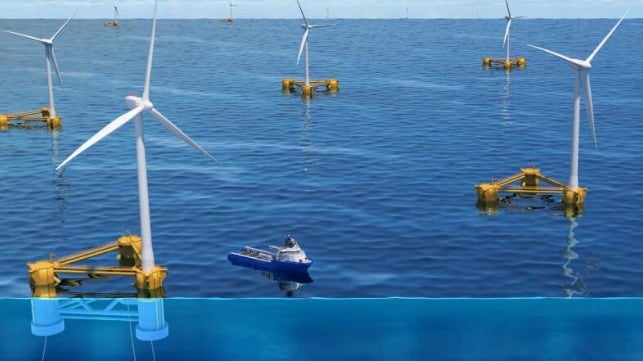Floating Offshore Wind Targets to be Missed as Realism Hits Industry

The enthusiasm about offshore wind as the anchor of an energy transition in the coming decades is fast waning with stakeholders now acknowledging that global capacity targets will fall short of projections. One of the sectors that continues to lag is floating wind turbines.
London-based energy consultancy Westwood writes in a new analysis that due to challenges and risks, the global offshore wind industry will only manage to bring on stream less than 3 GW of floating wind installations by 2030 and about 10 GW by 2040. Europe, which is leading the offshore wind race, will only manage to operationalize between 0.5 GW to 2 GW by 2030 and 8 GW by 2040 using floating technology.
The analysis highlights that recent market upheaval caused primarily by inflation, together with the subsequent re-focusing of developer strategies, means that global floating offshore targets will all be missed over the coming decades. Globally, there are over 3,000 identified offshore wind projects at various stages of development.
Westwood in partnership with Norwegian Offshore Wind and World Forum Offshore Wind carried out a survey of 184 floating offshore wind stakeholders on industry sentiment and attitudes across the value chain, with the outcome indicating lukewarm optimism has replaced the excitement of two years ago. In the survey, half of the stakeholders cited standardization of floating technology, manufacturing capability and capacity, and port infrastructure as three major challenges that will impede project deployment.
Recent market upheavals caused primarily by inflation coupled with a lack of clear government support in terms of policy and regulatory issues for technology development and a lack of investment in port infrastructures are adding to the risks facing offshore wind.
Respondents also cited a lack of suitable installation and support vessels, lack of access to finance, limited insurance options, unclear maritime boundaries/Economic Exclusive Zones, and a lack of available leases as some of the other obstacles facing the industry.
Europe is leading in terms of the downcast sentiment, with 42 percent of respondents being less optimistic about the floating offshore wind sector than they were two years ago, compared with 30 percent for non-Europe. Globally, only 44 percent of developers are more optimistic about the sector than two years ago whereas that shrinks to just under a quarter of supply chain respondents, potentially pointing to a lag in projects coming to tender for their services.
“The enthusiasm accompanying the flurry of activity following the 2022 leasing rounds and target setting has naturally waned, but our survey results demonstrate the appetite in the sector,” said David Linden, Westwood Head of Energy Transition.
He added that today a more realistic picture of near-term growth prospects of the offshore wind industry has emerged as obstacles impact deployments and even force developers to walk away from projects. The only upside is that optimism hasn’t wavered as much as anticipated.
“Right now, most respondents remain confident, but realistic, about the potential for floating wind. But we need to build manufacturing capability and capacity. And we also need to invest in infrastructure and port capacities,” noted Arvid Nesse, Norwegian Offshore Wind CEO.
According to the survey, the United Kingdom, South Korea, and China are the front-runners in bringing floating wind ambitions to fruition. In the UK, which has set an ambitious target of 50 GW by 2030, about three-quarters of the stakeholders believe projects will come on stream. In the U.S., where the industry is grappling with upheavals, only 19 percent of the respondents are optimistic about the industry’s prospects. The Biden administration has set a goal of 15 GW of floating offshore wind by 2035 and in February 2023 launched a research initiative with a goal of reducing the costs of floating offshore wind energy by over 70 percent by 2035.
Overall, Westwood remains optimistic about the outlook for wind projecting in April 2024 that more than 70 GW of lease capacity will be awarded in 2024, a 67 percent increase in comparison to 2023. However, with delays and some developers backing out of projects in the pipeline, Westwood also reduced its cumulative global offshore wind capacity is forecast to reach 414 GW by 2032, a 7.4 percent decrease in comparison to its 1H 2023 forecast.
